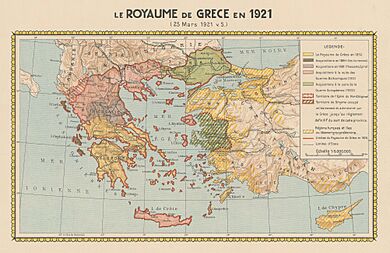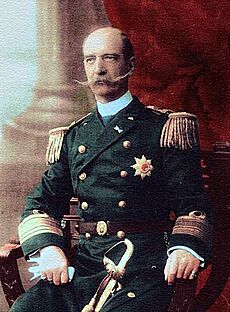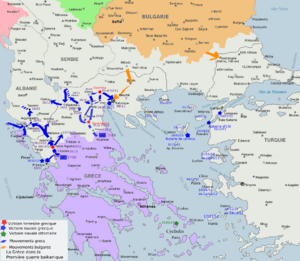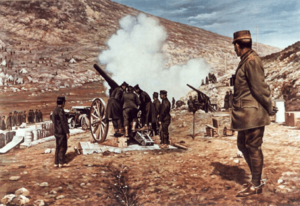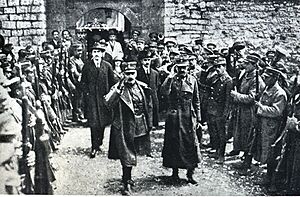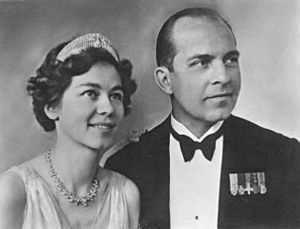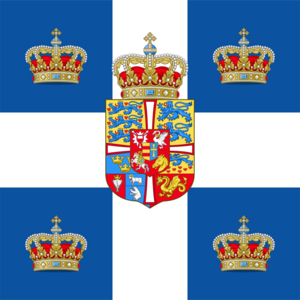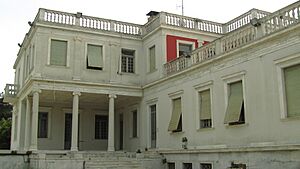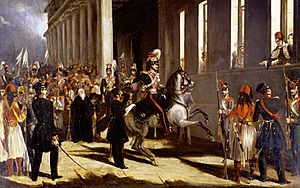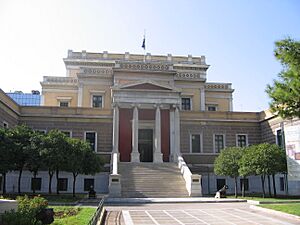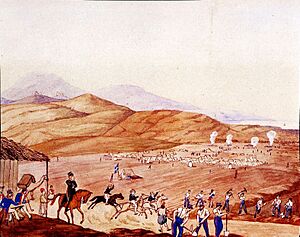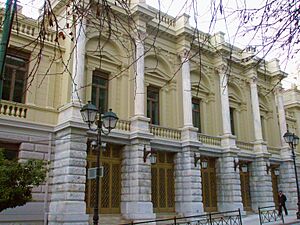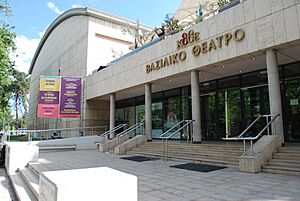Kingdom of Greece facts for kids
Quick facts for kids
Kingdom of Greece
Βασίλειον τῆς Ἑλλάδος
Vasíleion tis Elládos |
|||||||||||||||||||||||||||||||
|---|---|---|---|---|---|---|---|---|---|---|---|---|---|---|---|---|---|---|---|---|---|---|---|---|---|---|---|---|---|---|---|
| 1832–1924 1935–1973 |
|||||||||||||||||||||||||||||||
|
Flag
(1863–1973) Coat of arms
(1936–1973) |
|||||||||||||||||||||||||||||||
|
Motto:
|
|||||||||||||||||||||||||||||||
|
|
|||||||||||||||||||||||||||||||

The Kingdom of Greece during the Cold War
|
|||||||||||||||||||||||||||||||
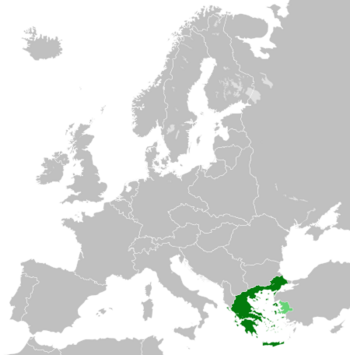
The Kingdom of Greece during the Greco-Turkish War
|
|||||||||||||||||||||||||||||||
| Capital | |||||||||||||||||||||||||||||||
| Largest city | Athens | ||||||||||||||||||||||||||||||
| Official languages | Greek | ||||||||||||||||||||||||||||||
| Religion | Greek Orthodoxy (official) | ||||||||||||||||||||||||||||||
| Demonym(s) | Greek | ||||||||||||||||||||||||||||||
| Government | Unitary absolute monarchy (1832–1844) Unitary parliamentary constitutional monarchy
|
||||||||||||||||||||||||||||||
| King | |||||||||||||||||||||||||||||||
|
• 1832–1862 (first)
|
Otto | ||||||||||||||||||||||||||||||
|
• 1964–1973 (last)
|
Constantine II | ||||||||||||||||||||||||||||||
| Prime Minister | |||||||||||||||||||||||||||||||
|
• 1833 (first)
|
Spyridon Trikoupis | ||||||||||||||||||||||||||||||
|
• 1967–1973 (last)
|
Georgios Papadopoulos | ||||||||||||||||||||||||||||||
| Legislature | None (rule by decree) (1832–1844) Parliament (1843–1924; 1935–1941; 1944–1973) |
||||||||||||||||||||||||||||||
| Senate (1844–1864) |
|||||||||||||||||||||||||||||||
| Chamber of Deputies (1844–1863) |
|||||||||||||||||||||||||||||||
| Historical era | Modern | ||||||||||||||||||||||||||||||
| 30 August 1832 | |||||||||||||||||||||||||||||||
|
• Constitution granted
|
3 September 1843 | ||||||||||||||||||||||||||||||
|
• King Otto ousted
|
23 October 1862 | ||||||||||||||||||||||||||||||
|
• Goudi coup
|
28 August 1909 | ||||||||||||||||||||||||||||||
|
• Balkan Wars
|
1912–1913 | ||||||||||||||||||||||||||||||
|
• National Schism
|
1915–1917 | ||||||||||||||||||||||||||||||
| 1919–1922 | |||||||||||||||||||||||||||||||
|
• Second Republic
|
1924–1935 | ||||||||||||||||||||||||||||||
|
• Metaxas regime
|
1936–1941 | ||||||||||||||||||||||||||||||
|
• Axis occupation
|
1941–1944 | ||||||||||||||||||||||||||||||
|
• Greek Civil War
|
1943–1949 | ||||||||||||||||||||||||||||||
| 25 October 1945 | |||||||||||||||||||||||||||||||
|
• Military Junta
|
21 April 1967 | ||||||||||||||||||||||||||||||
|
• Republic declared
|
1 June 1973 | ||||||||||||||||||||||||||||||
| Currency | Greek drachma (₯) | ||||||||||||||||||||||||||||||
|
|||||||||||||||||||||||||||||||
| Today part of | |||||||||||||||||||||||||||||||
The Kingdom of Greece (Greek: Βασίλειον τῆς Ἑλλάδος) was a country in Europe. It was formed in 1832, after Greece gained full independence from the Ottoman Empire. This independence was recognized by the Treaty of Constantinople.
The Kingdom of Greece ended in 1924, and the Second Hellenic Republic was created. This happened after Greece lost a war against Turkey. The monarchy was brought back in 1935 and lasted until 1973. The kingdom finally ended after a military government ruled Greece from 1967 to 1974. A public vote in 1974 then established the Third Hellenic Republic.
Contents
The Start of the Kingdom of Greece
How Greece Became Independent
For many centuries, Greece was part of the Ottoman Empire. This empire had grown very strong after taking over the Eastern Roman Empire (also known as the Byzantine Empire) in 1453. However, Greeks living in the mountains often fought against Ottoman rule.
Greeks strongly desired to be free. In 1814, three Greeks in Odesa formed a secret group called the Filiki Eteria. Their goal was to unite all Greeks to fight for freedom from the Ottoman Empire. Many revolts were planned. The first major one began on March 6, 1821. By the end of that month, the Peloponnese region was in full revolt. This started the Greek War of Independence.
The Greek War of Independence (1821–1832)
In 1821, Greeks in the Peloponnese region rebelled against the Ottoman Empire. This war led to the creation of the first independent Greek state since the 1400s. In 1822, Greece declared its independence and created its first constitution. However, the new state was not stable and lacked strong allies.
Powerful countries like the United Kingdom, the Russian Empire, and France saw a chance to weaken the Ottoman Empire. They supported Greece in gaining its independence. After a big naval battle in Navarino Bay, a ceasefire was agreed upon. Greece's full independence was recognized in 1830.
In 1831, Greece's first leader, Ioannis Kapodistrias, was assassinated. This caused a lot of instability. To keep Greece stable and connected to its allies, Greece agreed to become a kingdom in 1832. Prince Otto von Wittelsbach from Bavaria was chosen as the first king. He arrived in Greece in 1833.
Early Years of the Kingdom
King Otto's Rule (1832–1862)
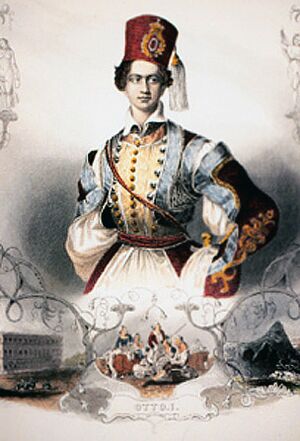
King Otto's rule lasted 30 years, but it was often difficult. In his early years, Bavarian officials ruled for him. They tried to impose German ideas on Greece and kept important jobs for themselves. This made them very unpopular. However, they did help set up Greece's government, army, justice, and education systems.
Otto wanted to rule Greece well, but he faced challenges. He was Roman Catholic, while most Greeks were Orthodox Christian. Also, he and his wife, Queen Amalia, had no children. The new kingdom also tried to stop traditional banditry, which sometimes meant fighting former revolutionary heroes.
By 1837, the Bavarian regents were sent home. Otto then appointed Greek ministers, but Bavarian officials still held many positions. Greece still had no parliament or constitution. Discontent grew, leading to a revolt in Athens in September 1843. King Otto agreed to grant a constitution. The new constitution created a parliament with two parts: an Assembly and a Senate.
Greek politics in the 1800s focused on the "Megali Idea" (Great Idea). This was the dream of uniting all Greek lands and making Constantinople its capital. Greeks in Ottoman territories, like Crete and Macedonia, often rebelled. During the Crimean War, the British occupied Piraeus to stop Greece from joining the war against the Ottomans.
Many Greek politicians grew tired of King Otto's interference. In 1862, he fired his prime minister, Konstantinos Kanaris. This led to a military rebellion, and Otto was forced to leave Greece. The Greeks then asked Britain for a new king. Prince George I of Denmark became the new king. He was popular because he agreed that his children would be raised Greek Orthodox. Britain also gave the United States of the Ionian Islands to Greece as a reward.
Religious Life
Under Ottoman rule, the Greek Church was part of the Ecumenical Patriarchate of Constantinople. When the Greek Kingdom was formed, the government decided to control the church. In 1833, the church was declared "autocephalous" (independent) from the Patriarchate. This decision caused political debates for decades. The Patriarchate finally recognized this new status in 1850.
Many small monasteries were closed in 1833. Priests in rural areas were often farmers who earned money from their farm work and from their parishioners. Few attended special schools for priests. In the 1840s, a religious revival spread across Greece. By the 1880s, the "Anaplasis" (Regeneration) Movement brought new spiritual energy. It promoted Bible study and catechism schools.
King George I's Rule (1863–1913)
In 1864, Greece adopted a more democratic constitution. The king's powers were reduced, and the Senate was removed. All adult men could now vote. However, Greek politics still revolved around powerful families. Two main political groups existed: the liberals, led by Charilaos Trikoupis and later Eleftherios Venizelos, and the conservatives, led by Theodoros Deligiannis.
Trikoupis and Deligiannis often took turns as prime minister. Trikoupis wanted to work with Britain, build infrastructure, and develop industries. Deligiannis focused on Greek nationalism and the "Megali Idea."
Greece remained a poor country in the 1800s. It lacked raw materials and good infrastructure. Farming was mostly for survival, and the main exports were currants, raisins, and tobacco. Some Greeks became rich as merchants and shipowners, making Piraeus a major port. But most of this wealth did not reach the farmers. Greece was deeply in debt to foreign banks.
By the 1890s, Greece was almost bankrupt. Poverty was widespread, especially in rural areas. Many Greeks moved to the United States. Despite financial problems, Athens successfully hosted the first modern 1896 Summer Olympics in 1896.

The way parliament worked improved under George I. In 1875, Charilaos Trikoupis introduced the idea that the prime minister must have the support of the majority in parliament. However, corruption and frequent changes in government still happened. Trikoupis's spending on projects like the Corinth Canal strained the economy. This led to Greece declaring bankruptcy in 1893.
Another unique issue in 19th-century Greece was the language question. Most Greeks spoke a form called Demotic. However, many educated people wanted to use a "purified" form called Katharevousa, which was closer to Ancient Greek. Government documents and newspapers used Katharevousa, which many ordinary Greeks could not read. When the New Testament was translated into Demotic in 1901, riots broke out in Athens. This issue continued for decades.
All Greeks wanted to free Greek-speaking areas still under Ottoman rule. In Crete, a long revolt from 1866 to 1869 increased nationalist feelings. In 1881, parts of Thessaly and Epirus were given to Greece. However, Greece did not get Crete, which disappointed many.
Greeks in Crete continued to rebel. In 1897, Greece declared war on the Ottomans. The Greek army was defeated. But powerful countries intervened, and Greece lost little land. Crete became an independent state. Nationalist feelings grew among Greeks in the Ottoman Empire. In 1908, the Young Turk Revolution happened in the Ottoman Empire.
Taking advantage of the Ottoman Empire's problems, Crete declared its union with Greece. The Greek government could not act, which angered many, especially young army officers. They formed a secret group called the "Military League" and staged a coup in 1909. They asked Eleftherios Venizelos, a liberal politician, to advise them. Venizelos quickly became a powerful figure and became Prime Minister in 1910.
Venizelos started major reforms. He introduced a new, more liberal constitution in 1911. He also reformed public administration, education, and the economy. French and British military experts were invited to help train the army and navy. The Ottoman Empire was weakening, as shown by its war with Italy in Libya.
In 1912, Greece, Bulgaria, Montenegro, and Serbia formed the Balkan League. In October 1912, they declared war on the Ottoman Empire.
Balkan Wars (1912–1913)
The Balkan Wars were a series of conflicts that greatly expanded Greece's territory. In the First Balkan War (1912–1913), Greece joined other Balkan states against the Ottoman Empire. The Greek army, led by Crown Prince Constantine, advanced north. They captured Thessaloniki, a very important city, in November 1912. This was a major victory that weakened the Ottoman forces.
In the Epirus region, the Greek army faced strong defenses around Ioannina. After receiving reinforcements, they captured Ioannina in March 1913. This allowed the Greek army to move into what is now southern Albania.
The Greek navy played a key role in the Aegean Sea. They quickly took control of many islands, like Lemnos, which became a forward base. This prevented the Ottoman fleet from leaving the Dardanelles straits. Lieutenant Nikolaos Votsis famously sank an Ottoman battleship in Thessaloniki harbor.
The Greek fleet won two major battles against the Ottoman fleet, the Naval Battle of Elli and the Naval Battle of Lemnos. These victories gave Greece control of the Aegean Sea. The Greek navy also blocked Ottoman supply routes, helping the land forces.

The First Balkan War ended with the Treaty of London. However, the allies disagreed on how to divide Macedonia. In June 1913, Bulgaria attacked Greece and Serbia, starting the Second Balkan War. Bulgaria was defeated. The Treaty of Bucharest ended this war. Greece gained southern Epirus, the southern half of Macedonia, Crete, and many Aegean islands. These gains nearly doubled Greece's size and population.
Challenges and Changes (1914–1949)
World War I and the National Schism

In March 1913, King George was assassinated, and his son, Constantine I, became king. Constantine was the first Greek-born king and the first Greek Orthodox king. He was very popular, especially after leading the army in the Balkan Wars. His popularity was only matched by Prime Minister Venizelos.
When World War I started in 1914, Greece was allied with Serbia. However, both King Constantine and Venizelos wanted Greece to stay neutral at first. Their views soon differed. Constantine had studied in Germany and was married to the German Kaiser's sister. He believed Germany would win. Venizelos admired Britain and believed the Allies would win.
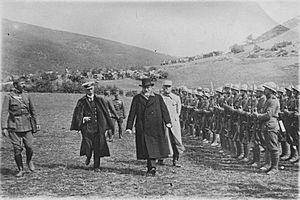
Since Greece relied on the sea, it could not oppose the powerful British navy. King Constantine wanted to stay neutral. Venizelos wanted Greece to join the war on the Allied side. Venizelos resigned but won the next elections. When Bulgaria joined Germany in October 1915, Venizelos invited Allied forces into Greece. Constantine dismissed him again.
This led to the "National Schism"—a deep division in Greek society between supporters of Venizelos and supporters of the King. In 1916, Venizelos formed a separate government in Thessaloniki. The Allies put pressure on King Constantine. In June 1917, Constantine was forced to leave the country, though he did not officially give up his throne. His second son, Alexander, became king. Venizelos then led Greece into the war on the Allied side.
After World War I and the Asia Minor Campaign
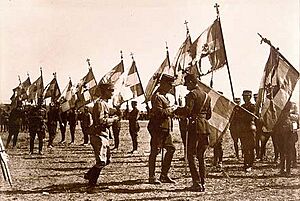
After World War I ended in 1918, the Ottoman Empire was defeated. Greece expected to gain more land, as promised by the Allies. Thanks to Venizelos's efforts, Greece gained Western Thrace in 1919 and Eastern Thrace and a zone around Smyrna in western Anatolia in 1920.
However, a strong nationalist movement grew in Turkey, led by Mustafa Kemal. He set up a rival government and fought the Greek army. In Greece, Venizelos's party lost the 1920 elections. King Constantine returned from exile after King Alexander's sudden death. The new government intensified the war in Anatolia.
The return of King Constantine caused problems. Many experienced officers who supported Venizelos were dismissed from the army. Also, Italy and France stopped supporting Greece and began supporting Kemal. In August 1922, the Turkish army defeated the Greek front and took Smyrna.
The Greek army left Anatolia and Eastern Thrace. A large-scale population exchange happened, with over 1.5 million Christians moving to Greece and almost half a million Muslims moving to Turkey. This disaster ended the "Megali Idea" dream. Greece was left exhausted and had to house many refugees.
This crisis led to more political problems. The army, led by officers who supported Venizelos, rebelled. King Constantine was forced to leave again in September 1922. His son, George II, became king. In 1924, King George II was asked to leave the country. On March 25, 1924, the Second Hellenic Republic was declared.
Monarchy Returns and Dictatorship (1935–1941)
On October 10, 1935, Georgios Kondylis, a former Venizelist, abolished the Republic and brought back the monarchy. A rigged public vote confirmed this change, and King George II returned.
King George II soon dismissed Kondylis. Eleftherios Venizelos, who was in exile, urged an end to the conflict over the monarchy. He saw the growing threat from Fascist Italy. The 1936 elections resulted in no clear winner, and no government could be formed.
Many political leaders died around this time, clearing the way for Ioannis Metaxas. Metaxas, a retired general, believed a strong government was needed to prevent social unrest. On August 4, 1936, with the king's support, he suspended parliament and established the "4th of August Regime" (a dictatorship).
Metaxas's government suppressed communists and exiled liberal leaders. It promoted ideas like the "Third Hellenic Civilization" and created a national youth organization. It also introduced social security measures to gain public support. The regime lacked wide public support, but most Greeks did not actively oppose it. Metaxas also improved Greece's defenses, building the "Metaxas Line" to prepare for war. Despite his admiration for Fascism, Metaxas kept Greece neutral. In April 1939, Italy took over Albania, and Britain promised to protect Greece's borders. So, when World War II began in September 1939, Greece remained neutral.
World War II and Civil War (1940–1949)
Even though Greece was neutral, Mussolini of Italy wanted to expand his empire. Italy attacked Greece on October 28, 1940, starting the Greco-Italian War. The Greeks fought back bravely and pushed the Italians into Albania. Metaxas died in January 1941. King George kept the dictatorship in place.
Adolf Hitler was forced to send German troops to help Italy. On April 6, 1941, Germany attacked Greece through Yugoslavia and Bulgaria. Despite help from Britain, Germany quickly took over most of Greece by the end of May. The king and government fled to Crete, then to Egypt, where they formed a government in exile.


Greece was divided into German, Italian, and Bulgarian zones. A puppet government was set up in Athens. Greece suffered terribly during the war. Germans took most of the country's food, leading to a severe famine in 1941–1942. Hundreds of thousands of people died.
In the mountains, several resistance movements formed. By mid-1943, Axis forces only controlled major towns. The largest resistance group, the National Liberation Front (EAM), was controlled by Communists. A civil war soon broke out between EAM and non-Communist groups. The exiled government in Cairo had little influence in Greece.
As Germany's defeat neared, Greek political groups formed a government of national unity in May 1944. This government included EAM members.
The Greek Civil War (1946–1949)
When German forces left Greece on October 12, 1944, the government in exile returned to Athens. The EAM-ELAS guerrilla army controlled most of Greece. However, their leaders did not take full control because Stalin had agreed that Greece would be under British influence.
Tensions grew between the British-backed government and EAM. This led to a large pro-EAM protest in Athens on December 3, 1944, which turned violent. After three weeks of fighting, the Communists were defeated. The Varkiza agreement disarmed ELAS, and a shaky government was formed. A period of "White Terror" against EAM supporters made tensions worse.
The Communists boycotted the March 1946 elections, and fighting began again. By late 1946, the Communist Democratic Army of Greece was formed. It fought against the government's National Army, which was supported first by Britain and then by the United States.
The Communists had successes in 1947–1948. But with American support, the National Army slowly regained control. In 1949, the Communists suffered a major blow when Yugoslavia closed its borders to them. The National Army launched an offensive that forced the remaining rebels to surrender or flee. The civil war killed 100,000 people and caused huge economic damage. Many Greeks were displaced or emigrated.
After the war, Greece gained the Dodecanese islands from Italy in 1947. These were the last Greek-speaking areas to join Greece, except for Cyprus.
Postwar Greece and the End of the Monarchy (1950–1973)
After the Civil War, Greek politics were divided into three main groups: Right, Centre, and Left. In the early 1950s, the Centre parties gained power under General Nikolaos Plastiras. These governments had limited power and were heavily influenced by the United States.
The Left, which was excluded from politics, found a voice through the EDA party. This party became important but was kept out of decision-making.
Greece adopted five-year plans for economic development. Many Greeks emigrated, which helped reduce unemployment and contributed to high economic growth. Foreign money flowed into the country, and consumption increased. Tourism also grew, along with shipping and money sent home by Greeks living abroad. These factors helped Greece's economy.
Manufacturing grew significantly, especially in textiles, chemicals, and metallurgy. The construction sector also saw major growth.
In the 1960s, young people became a strong social force. They created new music and fashion. They also campaigned for Cyprus's independence and for education reforms. Greece was becoming more influenced by European trends.
The country entered a long political crisis. Elections were planned for April 1967. However, on April 21, 1967, a group of right-wing colonels, led by Colonel Georgios Papadopoulos, took power in a coup d'état. This established the "Regime of the Colonels."
The junta suppressed civil liberties, set up military courts, and banned political parties. Thousands of suspected communists and opponents were imprisoned or exiled. The junta was widely criticized abroad. Inside Greece, discontent grew after 1970 when the economy slowed down. In May 1973, a planned coup by the navy was stopped. In response, Papadopoulos tried to introduce some democracy. He abolished the monarchy and declared himself President of the Republic.
Government and Laws
Greek Constitutions and Monarchy
The first constitution of the Kingdom of Greece was the Greek Constitution of 1844. On September 3, 1843, the army and citizens in Athens rebelled. They demanded that King Otto grant a constitution.
The 1844 Constitution created a Constitutional Monarchy. It was based on the French and Belgian constitutions. The king was the main power, but legislative power was shared with the Parliament and Senate. Members of Parliament were elected for three years by all adult men. Senators were appointed for life by the king. This constitution was one of the first in Europe to allow universal male suffrage.
After King Otto was removed, a new constitution was drafted in 1864. This constitution moved Greece from a constitutional monarchy to a "Crowned Republic." It clearly stated that power came from the people. The Parliament became the only legislative body, and the Senate was abolished. Members of Parliament were elected directly and secretly.
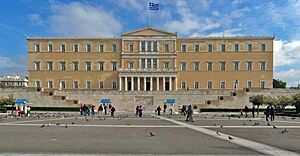
The 1864 Constitution also stated that the king appointed and dismissed ministers. However, it did not say that the king had to choose ministers supported by the majority in Parliament. This changed in 1875 when Charilaos Trikoupis pushed for the principle of "manifest confidence." King George I agreed that he would only appoint ministers who had the clear support of the majority in Parliament. This helped create a more stable parliamentary system.
The Greek Constitution of 1911 was another important step. After the Goudi revolt in 1909, Eleftherios Venizelos worked to reform the state. This led to major changes to the 1864 Constitution.
Important changes included better protection for personal safety, equal taxes, and the right to gather peacefully. The constitution also made it easier to take land to give to farmers who had no land. It also protected property rights. Other changes included a special court for election disputes and better protection for judges' independence. For the first time, the constitution made education mandatory and free for everyone. It also declared Katharevousa (a "purified" Greek) as the official language.
Economy of the Kingdom
Early Economy (19th Century)
When Greece became independent, its countryside was damaged by war. Farming was basic, and communication was poor, making trade difficult. Greece had a wealthy merchant class and a lot of land taken from Muslim owners during the war.
Land Reform
Land reform was one of the first challenges for the new kingdom. The government wanted to create a class of free farmers. In 1835, a law gave credit to families to buy small farms. By 1870, most Greek farm families owned about 20 acres. These farms were small, but the reform helped create a society where Greeks could support themselves.

20th Century Economy
The wars between 1912 and 1922 helped Greek industry grow. Factories for textiles, ammunition, and boots were built to supply the military. After the wars, these factories switched to making civilian goods. Greek refugees from Asia Minor, many of whom were skilled and had money, also boosted Greek industry and banking.
These refugees also caused cities like Athens and Thessaloniki to grow quickly. Many economists believe these refugees helped Greek industry stay competitive in the 1920s because there were many workers, which kept wages low.
Currency Problems
Greece faced budget problems. In 1922, the Finance Minister decided to "cut" each drachma (Greek currency) in half. Half its value was kept by the owner, and the other half was given to the government for a 20-year loan. This brought in money for the state, and inflation was low. This was done again in 1926. These policies made people lose trust in the government, and investment decreased.
The Great Depression
When the Great Depression hit Greece in 1932, the Bank of Greece tried to control it, but largely failed. Greece's foreign money reserves were almost gone. Money sent from Greeks abroad dropped sharply. The value of the drachma fell.
This was bad for Greece because it relied on imports for many basic needs. Greece stopped using the gold standard in 1932 and stopped paying interest on its debts. The country also started using protectionist policies, like import limits. These policies, along with a weak drachma, helped Greek industry grow during the Depression. By 1939, Greek industrial output was 179% of what it was in 1928. Despite the global depression, Greece grew by an average of 3.5% from 1932 to 1939.
Shipping and Tourism
Greece has always been a major player in shipping due to its geography. The Greek shipping industry grew strong after the Treaty of Küçük Kaynarca in 1774. This treaty allowed Greek ships to register under the Russian flag, avoiding Ottoman control. After both world wars, the Greek shipping industry recovered quickly. Shipping remains one of Greece's strongest economic sectors.

In the 1960s and 1970s, tourism became a major source of income for Greece. At first, some in the government and the Church opposed it, fearing it would be unstable or bad for morals. However, tourism grew significantly and was encouraged by governments because it brought in much-needed foreign money. Today, tourism makes up a large part of Greece's economy.
Post-World War II Economy
Greece suffered much more than other Western European countries during World War II. Heavy resistance led to German attacks on civilians. Greece relied on imported food, and a British naval blockade, along with food transfers to Germany, caused a severe famine. It is estimated that Greece's population dropped by 7% during the war. Greece also experienced extreme inflation.
After the Civil War ended in 1950, Greece's economy was in a very bad state. However, Greece grew much faster than most other countries with similar economies at the time. Between 1950 and 1973, Greece's economy grew by an average of 7% per year, a rate second only to Japan's.
Culture and Arts
Visual Arts
Modern Greek art began to develop around the time of Romanticism. Greek artists were influenced by European styles. This led to a unique Greek Romantic art style, inspired by revolutionary ideas, geography, and history. In the 19th century, a major art movement was "academic realism," often called the "Munich School" in Greece. Many Greek artists trained in Munich.
Important sculptors of the new Greek Kingdom included Leonidas Drosis and Yannoulis Chalepas.
Theatre
Modern Greek theatre started after Greece gained independence in the early 1800s. It was first influenced by Italian opera. The Nobile Teatro di San Giacomo di Corfù was the first theatre in modern Greece. It hosted the first Greek opera. In the late 19th and early 20th centuries, Athenian theatre featured musical comedies and operettas.
The National Theatre of Greece was founded in 1880. Famous Greek playwrights include Nikos Kazantzakis and Iakovos Kambanelis. Well-known actors include Katina Paxinou and Manos Katrakis.
Cinema
Cinema first appeared in Greece at the 1896 Summer Olympics. The first movie theatre opened in 1907. In 1914, the Asty Films Company was founded, and longer films began to be made. Golfo (Γκόλφω) is considered the first Greek long movie. In 1931, Daphnis and Chloe was the first Greek movie shown abroad. In 1944, Katina Paxinou won an Academy Award for her role in For Whom the Bell Tolls.
The 1950s and early 1960s are seen as the Golden Age of Greek Cinema. Directors and actors like Michael Cacoyannis, Melina Mercouri, and Irene Papas became famous in Greece and internationally. More than sixty films were made each year. Notable films include Η κάλπικη λίρα (1955) and Stella (1955). Cacoyannis also directed Zorba the Greek, which received many awards.
The Royal Family
Most members of the former Greek royal family live abroad. Constantine II and his wife, Anne-Marie, returned to Greece in 2013. As descendants of King Christian IX of Denmark, they are often called Princes or Princesses of Greece and Denmark.
Kings of Greece
| Name | Portrait | Reign |
|---|---|---|
| Otto |  |
6 February 1833 – 23 October 1862 |
| George I | 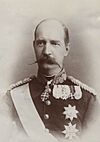 |
30 March 1863 – 18 March 1913 |
| Constantine I (1st reign) |
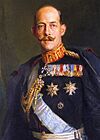 |
18 March 1913 – 11 June 1917 |
| Alexander |  |
11 June 1917 – 25 October 1920 |
| Constantine I (2nd reign) |
 |
19 December 1920 – 27 September 1922 |
| George II (1st reign) |
 |
27 September 1922 – 25 March 1924 |
| Second Hellenic Republic | ||
| George II (2nd reign) |
 |
3 November 1935 – 1 April 1947 |
| Paul | 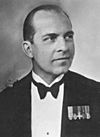 |
1 April 1947 – 6 March 1964 |
| Constantine II |  |
6 March 1964 – 1 June 1973 |
| Third Hellenic Republic | ||
Images for kids
See also
 In Spanish: Reino de Grecia para niños
In Spanish: Reino de Grecia para niños
- Coat of arms of Greece
- Greek royal family
- History of modern Greece
- List of heads of state of Greece
- Monarchy of Greece





